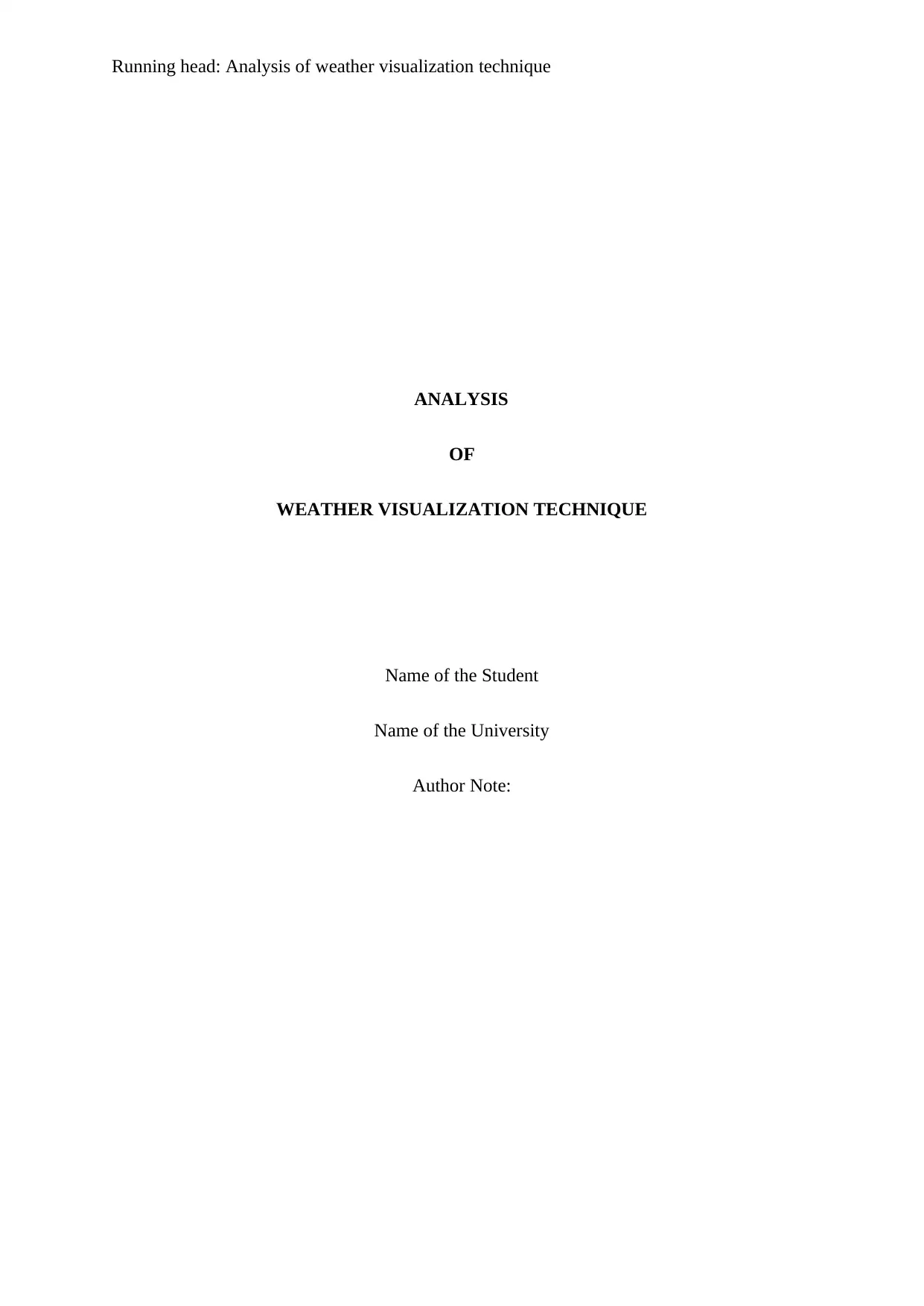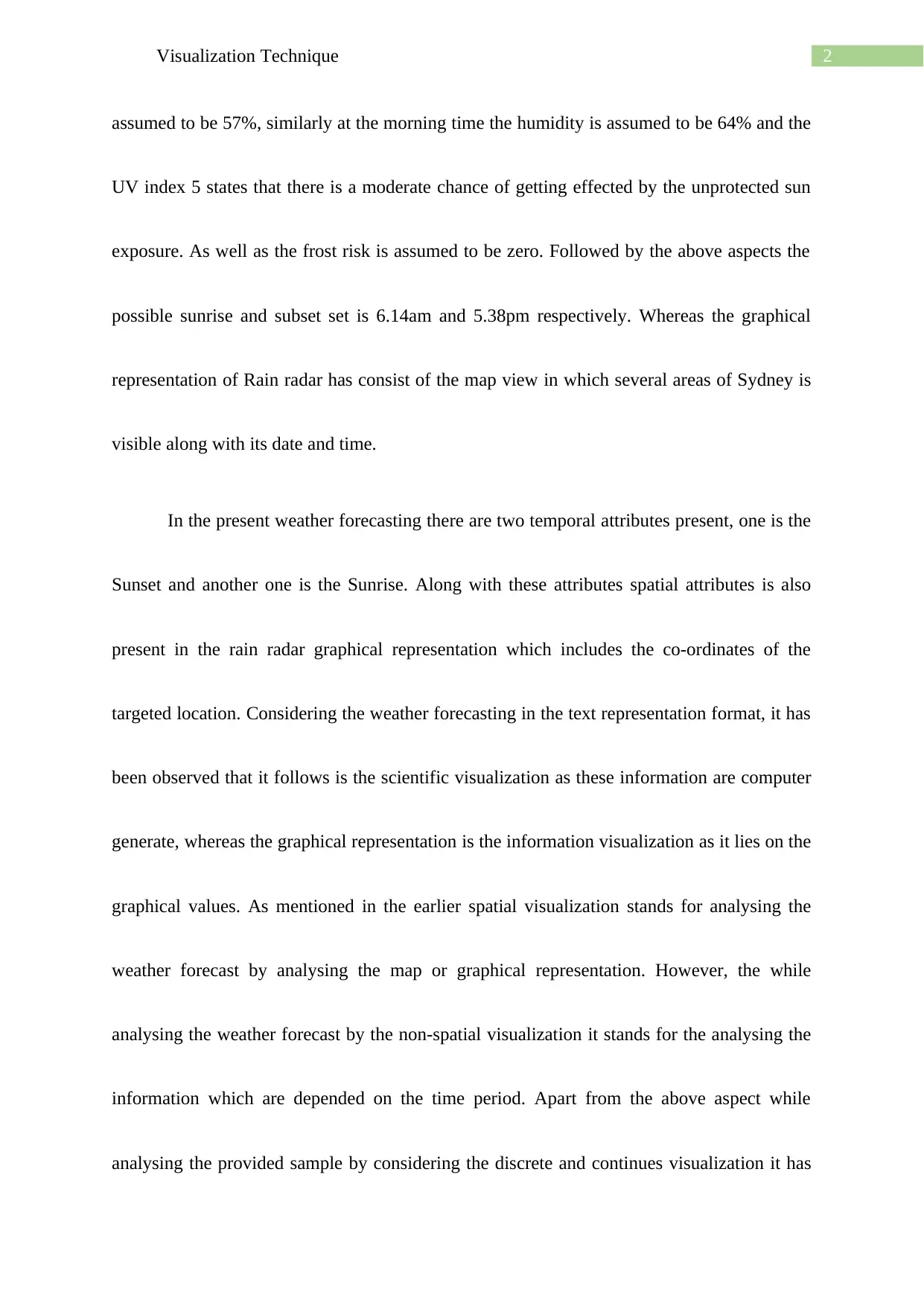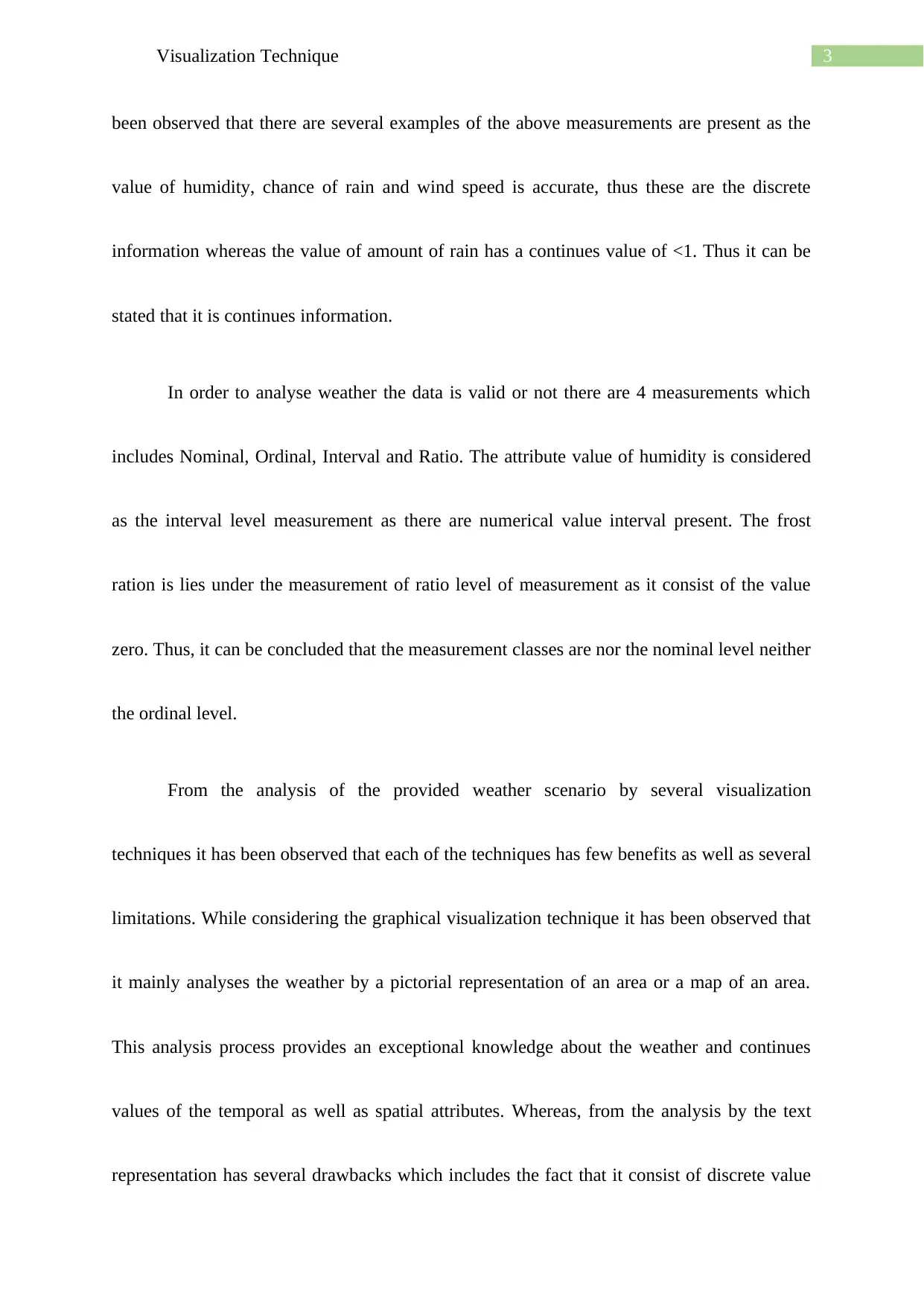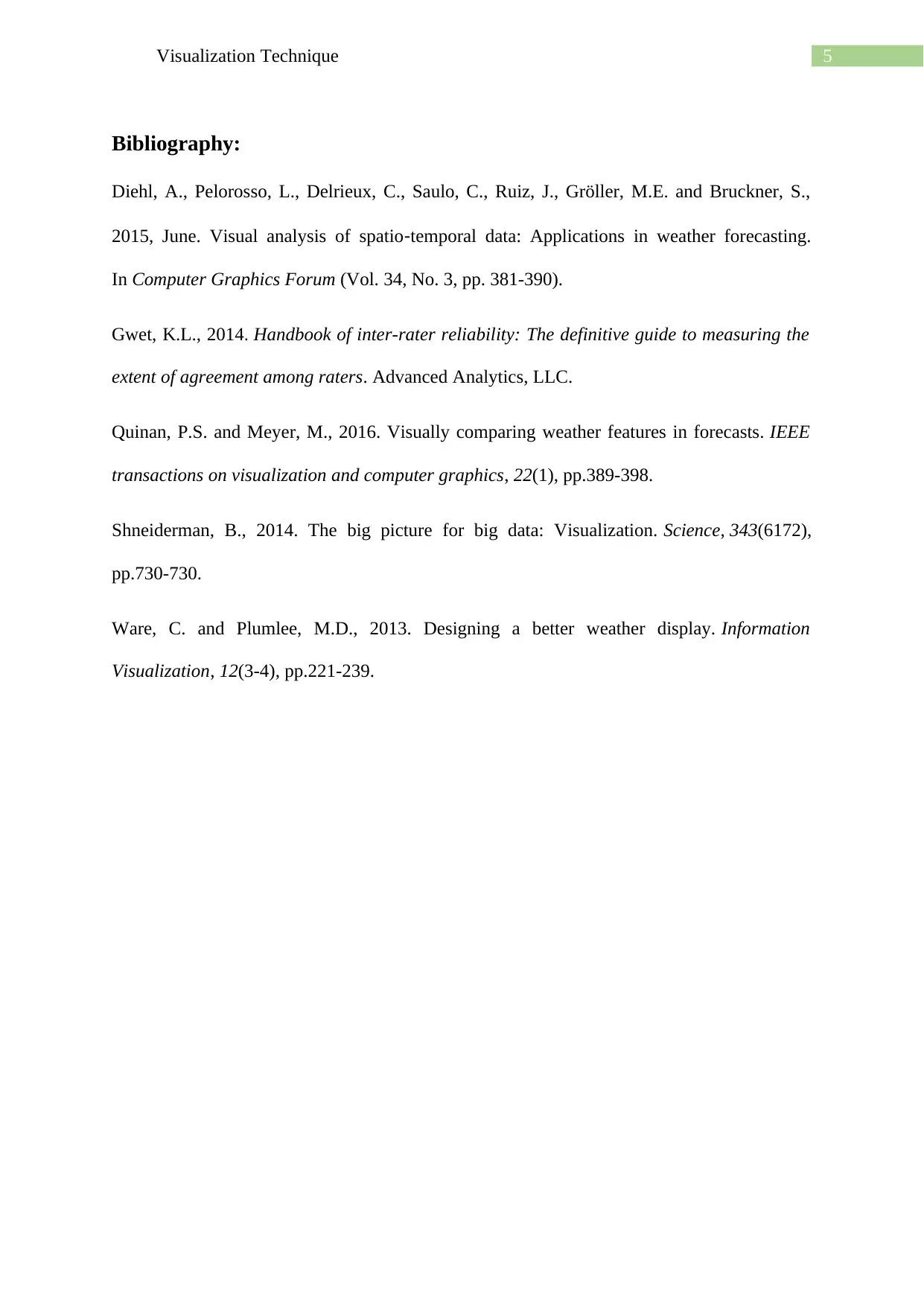Data Science Report: Analysis of Weather Visualization Techniques
VerifiedAdded on 2023/01/18
|6
|1093
|43
Report
AI Summary
This report provides an in-depth analysis of weather visualization techniques, focusing on the rain radar graphical visualization and text-based weather reports. The analysis examines the structure and meaning of the data, identifying spatial and temporal attributes. It categorizes visualization techniques as scientific versus information visualization, and spatial versus non-spatial visualization, and continuous versus discrete data visualization. The report explores the different levels of data measurement, including nominal, ordinal, interval, and ratio. Furthermore, it critically assesses the strengths and weaknesses of each visualization technique and how context is provided through filters, groups, and sets. The report concludes by summarizing the key findings and discussing the overall effectiveness of the weather visualization methods.

Running head: Analysis of weather visualization technique
ANALYSIS
OF
WEATHER VISUALIZATION TECHNIQUE
Name of the Student
Name of the University
Author Note:
ANALYSIS
OF
WEATHER VISUALIZATION TECHNIQUE
Name of the Student
Name of the University
Author Note:
Paraphrase This Document
Need a fresh take? Get an instant paraphrase of this document with our AI Paraphraser

1Visualization Technique
Rain Radar data Visualization:
After the analysis of mentioned information present in the provided scenario related to
the weather, it has been observed that two types of representation of the weather information
is given one is the graphical data and another one is the text data which is representing the
current weather. In the text representation on the current weather of Sydney, it has
maintained a tabular structure in which there are 6 major attributes which include the ‘Chance
of rain’, ‘Wind speed and Direction’, ‘Amount of rain’, ‘Humidity’, ‘UV Index’, ‘Frost
Risk’, ‘Sunrise’ as well as the ‘Sunset’. Where the value in the ‘Chance of rain’ is 30%,
which conveys that among the entire area only 30% will be affected by the rain if it rains, in
other words it also refers that the weather forecast has assumed that in the area there is only
30% of chances to arrive the rain. In the attribute ‘Wind Speed and direction’ it has the value
of AM 14kph SW & PM 16kph SSE, which states that the speed of the wind at the morning
time is assumed to be 14kph in the direction of south-west, similarly with the direction of
south-south-east the wind speed at the night time is assumed to be 16kph. Amount of rain <1
is indicates that during the raining time the amount of rain will be less than 1 which is very
small amount of rain that appears in a large area. Along with that it has also included the
value of Humidity as well as UV index which indicates that at the night time the humidity is
Rain Radar data Visualization:
After the analysis of mentioned information present in the provided scenario related to
the weather, it has been observed that two types of representation of the weather information
is given one is the graphical data and another one is the text data which is representing the
current weather. In the text representation on the current weather of Sydney, it has
maintained a tabular structure in which there are 6 major attributes which include the ‘Chance
of rain’, ‘Wind speed and Direction’, ‘Amount of rain’, ‘Humidity’, ‘UV Index’, ‘Frost
Risk’, ‘Sunrise’ as well as the ‘Sunset’. Where the value in the ‘Chance of rain’ is 30%,
which conveys that among the entire area only 30% will be affected by the rain if it rains, in
other words it also refers that the weather forecast has assumed that in the area there is only
30% of chances to arrive the rain. In the attribute ‘Wind Speed and direction’ it has the value
of AM 14kph SW & PM 16kph SSE, which states that the speed of the wind at the morning
time is assumed to be 14kph in the direction of south-west, similarly with the direction of
south-south-east the wind speed at the night time is assumed to be 16kph. Amount of rain <1
is indicates that during the raining time the amount of rain will be less than 1 which is very
small amount of rain that appears in a large area. Along with that it has also included the
value of Humidity as well as UV index which indicates that at the night time the humidity is

2Visualization Technique
assumed to be 57%, similarly at the morning time the humidity is assumed to be 64% and the
UV index 5 states that there is a moderate chance of getting effected by the unprotected sun
exposure. As well as the frost risk is assumed to be zero. Followed by the above aspects the
possible sunrise and subset set is 6.14am and 5.38pm respectively. Whereas the graphical
representation of Rain radar has consist of the map view in which several areas of Sydney is
visible along with its date and time.
In the present weather forecasting there are two temporal attributes present, one is the
Sunset and another one is the Sunrise. Along with these attributes spatial attributes is also
present in the rain radar graphical representation which includes the co-ordinates of the
targeted location. Considering the weather forecasting in the text representation format, it has
been observed that it follows is the scientific visualization as these information are computer
generate, whereas the graphical representation is the information visualization as it lies on the
graphical values. As mentioned in the earlier spatial visualization stands for analysing the
weather forecast by analysing the map or graphical representation. However, the while
analysing the weather forecast by the non-spatial visualization it stands for the analysing the
information which are depended on the time period. Apart from the above aspect while
analysing the provided sample by considering the discrete and continues visualization it has
assumed to be 57%, similarly at the morning time the humidity is assumed to be 64% and the
UV index 5 states that there is a moderate chance of getting effected by the unprotected sun
exposure. As well as the frost risk is assumed to be zero. Followed by the above aspects the
possible sunrise and subset set is 6.14am and 5.38pm respectively. Whereas the graphical
representation of Rain radar has consist of the map view in which several areas of Sydney is
visible along with its date and time.
In the present weather forecasting there are two temporal attributes present, one is the
Sunset and another one is the Sunrise. Along with these attributes spatial attributes is also
present in the rain radar graphical representation which includes the co-ordinates of the
targeted location. Considering the weather forecasting in the text representation format, it has
been observed that it follows is the scientific visualization as these information are computer
generate, whereas the graphical representation is the information visualization as it lies on the
graphical values. As mentioned in the earlier spatial visualization stands for analysing the
weather forecast by analysing the map or graphical representation. However, the while
analysing the weather forecast by the non-spatial visualization it stands for the analysing the
information which are depended on the time period. Apart from the above aspect while
analysing the provided sample by considering the discrete and continues visualization it has
⊘ This is a preview!⊘
Do you want full access?
Subscribe today to unlock all pages.

Trusted by 1+ million students worldwide

3Visualization Technique
been observed that there are several examples of the above measurements are present as the
value of humidity, chance of rain and wind speed is accurate, thus these are the discrete
information whereas the value of amount of rain has a continues value of <1. Thus it can be
stated that it is continues information.
In order to analyse weather the data is valid or not there are 4 measurements which
includes Nominal, Ordinal, Interval and Ratio. The attribute value of humidity is considered
as the interval level measurement as there are numerical value interval present. The frost
ration is lies under the measurement of ratio level of measurement as it consist of the value
zero. Thus, it can be concluded that the measurement classes are nor the nominal level neither
the ordinal level.
From the analysis of the provided weather scenario by several visualization
techniques it has been observed that each of the techniques has few benefits as well as several
limitations. While considering the graphical visualization technique it has been observed that
it mainly analyses the weather by a pictorial representation of an area or a map of an area.
This analysis process provides an exceptional knowledge about the weather and continues
values of the temporal as well as spatial attributes. Whereas, from the analysis by the text
representation has several drawbacks which includes the fact that it consist of discrete value
been observed that there are several examples of the above measurements are present as the
value of humidity, chance of rain and wind speed is accurate, thus these are the discrete
information whereas the value of amount of rain has a continues value of <1. Thus it can be
stated that it is continues information.
In order to analyse weather the data is valid or not there are 4 measurements which
includes Nominal, Ordinal, Interval and Ratio. The attribute value of humidity is considered
as the interval level measurement as there are numerical value interval present. The frost
ration is lies under the measurement of ratio level of measurement as it consist of the value
zero. Thus, it can be concluded that the measurement classes are nor the nominal level neither
the ordinal level.
From the analysis of the provided weather scenario by several visualization
techniques it has been observed that each of the techniques has few benefits as well as several
limitations. While considering the graphical visualization technique it has been observed that
it mainly analyses the weather by a pictorial representation of an area or a map of an area.
This analysis process provides an exceptional knowledge about the weather and continues
values of the temporal as well as spatial attributes. Whereas, from the analysis by the text
representation has several drawbacks which includes the fact that it consist of discrete value
Paraphrase This Document
Need a fresh take? Get an instant paraphrase of this document with our AI Paraphraser

4Visualization Technique
of the attributes. As this types of representation has the mentioned drawback, the result
caused by this analysis gets directly affected.
In order to successfully visualize the weather information, the attributes of the context
are grouped as well as there are several valid attributes and values present which has
successfully represented the Rain Radar Weather Information.
of the attributes. As this types of representation has the mentioned drawback, the result
caused by this analysis gets directly affected.
In order to successfully visualize the weather information, the attributes of the context
are grouped as well as there are several valid attributes and values present which has
successfully represented the Rain Radar Weather Information.

5Visualization Technique
Bibliography:
Diehl, A., Pelorosso, L., Delrieux, C., Saulo, C., Ruiz, J., Gröller, M.E. and Bruckner, S.,
2015, June. Visual analysis of spatio‐temporal data: Applications in weather forecasting.
In Computer Graphics Forum (Vol. 34, No. 3, pp. 381-390).
Gwet, K.L., 2014. Handbook of inter-rater reliability: The definitive guide to measuring the
extent of agreement among raters. Advanced Analytics, LLC.
Quinan, P.S. and Meyer, M., 2016. Visually comparing weather features in forecasts. IEEE
transactions on visualization and computer graphics, 22(1), pp.389-398.
Shneiderman, B., 2014. The big picture for big data: Visualization. Science, 343(6172),
pp.730-730.
Ware, C. and Plumlee, M.D., 2013. Designing a better weather display. Information
Visualization, 12(3-4), pp.221-239.
Bibliography:
Diehl, A., Pelorosso, L., Delrieux, C., Saulo, C., Ruiz, J., Gröller, M.E. and Bruckner, S.,
2015, June. Visual analysis of spatio‐temporal data: Applications in weather forecasting.
In Computer Graphics Forum (Vol. 34, No. 3, pp. 381-390).
Gwet, K.L., 2014. Handbook of inter-rater reliability: The definitive guide to measuring the
extent of agreement among raters. Advanced Analytics, LLC.
Quinan, P.S. and Meyer, M., 2016. Visually comparing weather features in forecasts. IEEE
transactions on visualization and computer graphics, 22(1), pp.389-398.
Shneiderman, B., 2014. The big picture for big data: Visualization. Science, 343(6172),
pp.730-730.
Ware, C. and Plumlee, M.D., 2013. Designing a better weather display. Information
Visualization, 12(3-4), pp.221-239.
⊘ This is a preview!⊘
Do you want full access?
Subscribe today to unlock all pages.

Trusted by 1+ million students worldwide
1 out of 6
Your All-in-One AI-Powered Toolkit for Academic Success.
+13062052269
info@desklib.com
Available 24*7 on WhatsApp / Email
![[object Object]](/_next/static/media/star-bottom.7253800d.svg)
Unlock your academic potential
Copyright © 2020–2025 A2Z Services. All Rights Reserved. Developed and managed by ZUCOL.

